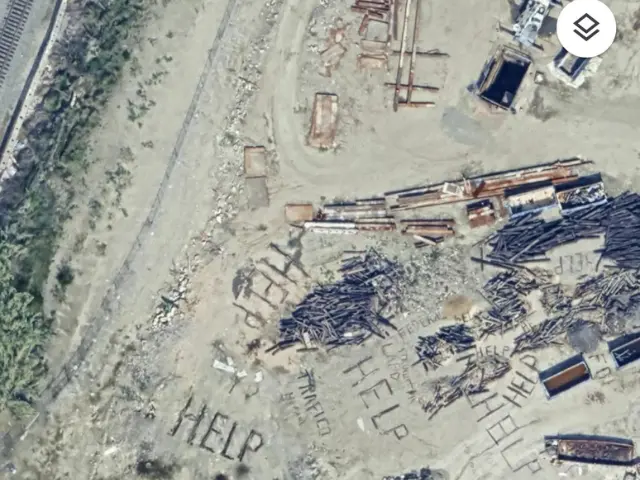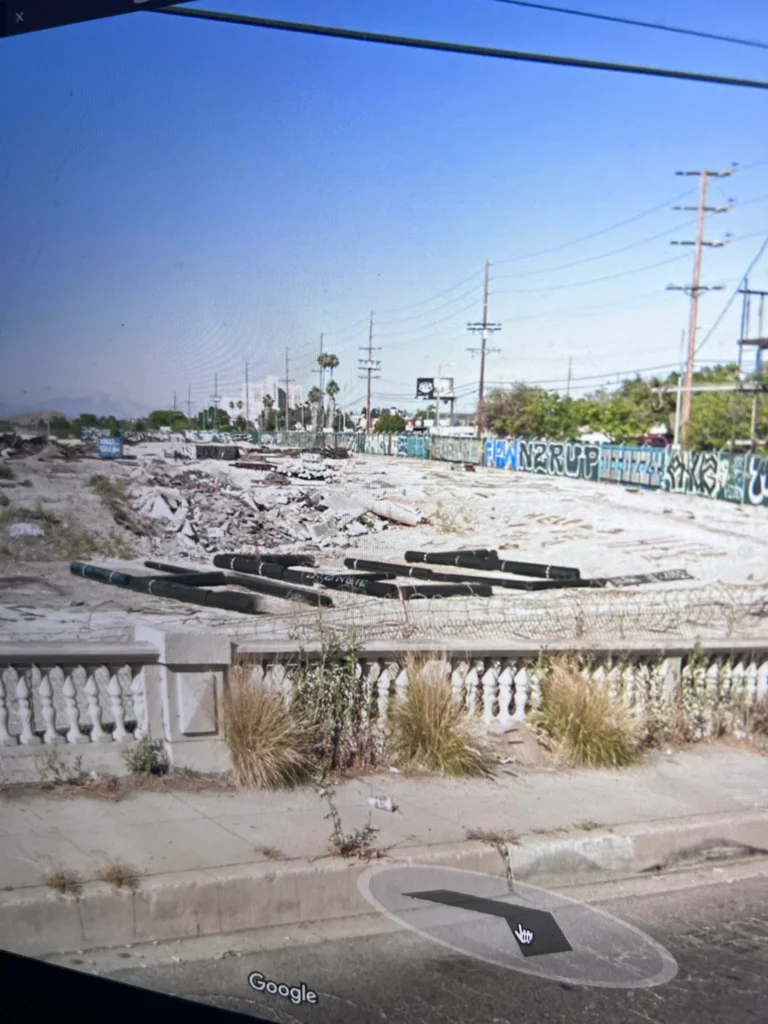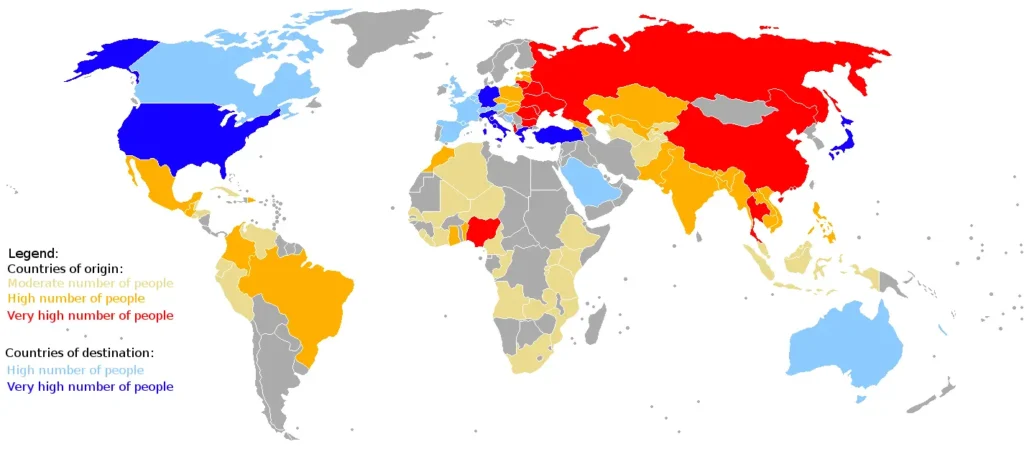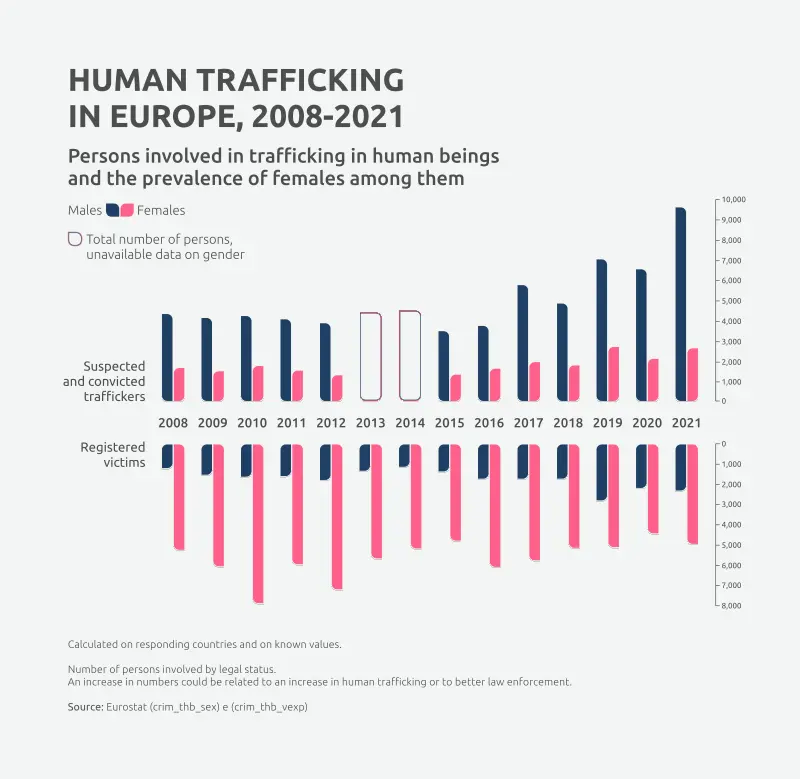Address
304 North Cardinal St.
Dorchester Center, MA 02124
Work Hours
Monday to Friday: 7AM - 7PM
Weekend: 10AM - 5PM

In January 2025, the internet erupted with speculation after the discovery of large “HELP” and “TRAFICO” messages on Google Maps, near the Union Pacific railroad yard in Los Angeles. The eerie messages, seemingly etched onto the ground using construction debris, quickly gained traction across social media platforms. Many users speculated that they were distress signals from human trafficking victims, while others suspected an elaborate hoax designed to stoke public fear or promote an unknown agenda.
As public interest grew, discussions on social media ranged from genuine concern to outright skepticism. Some believed the messages were left by victims of forced labor or sexual exploitation, trapped within the massive industrial zone. Others, however, suggested that activists or pranksters might have created them to bring attention to issues such as homelessness and labor exploitation. Regardless of their origin, the appearance of these messages has reignited important conversations about trafficking, the role of digital tools in investigations, and the importance of public vigilance and responsible reporting.
The ongoing lack of an official response from law enforcement has fueled speculation and misinformation. This article aims to explore the possible explanations for the mysterious messages, analyze the role of technology in trafficking investigations, and examine how the public can responsibly engage with such findings especially when dealing with the red flags of human trafficking.

Reports indicate that the first instance of the messages was noticed by social media users in early 2025, but archived satellite images show that they may have been present as far back as June 2023. This revelation has raised several questions about how such an obvious distress call went unnoticed for so long. Some local residents have stated that similar messages had appeared in nearby areas before but were quickly removed by authorities, sparking further speculation about whether authorities were aware of their existence earlier but chose not to publicize them.
The fact that the words “HELP” and “TRAFICO” appeared in an area known for high shipping traffic, proximity to homeless encampments, and minimal public oversight has led many to suspect that the messages could be related to illegal activities taking place in the industrial sector. Advocacy groups have pointed out that traffickers often exploit industrial locations where transient populations and shipping operations make it easier to hide in plain sight.
Eyewitness reports from individuals who visited the location describe a sense of unease and suggestive evidence of makeshift shelters within the vicinity. Some claimed to have seen footprints leading to the containers where the messages were reportedly written, further deepening suspicions that vulnerable individuals may have sought refuge there. The presence of discarded clothing, food packaging, and other personal items has led some OSINT analysts to speculate that the site might have been temporarily inhabited.
Adding to the complexity, the viral nature of the discovery has resulted in an influx of online sleuths attempting to verify the location independently. This has led to conflicting reports, with some claiming that certain aspects of the original discovery have been altered or erased since the initial findings went public. The rapid spread of the story online has also drawn the attention of local media outlets, yet official channels remain silent, further intensifying curiosity and concern. With disasters like the current California wildfires also increasing human trafficking risks, public concern regarding these signs is significant.

Los Angeles is one of the largest human trafficking hubs in the United States, with thousands of cases reported each year. The city’s extensive network of highways, ports, and transportation infrastructure makes it a prime location for traffickers seeking to move victims across state and international borders. According to the Los Angeles County Human Trafficking Task Force, cases of both sex trafficking and forced labor have been on the rise, with vulnerable individuals often recruited through deception, coercion, or outright abduction.
Victims of trafficking in Los Angeles often come from marginalized communities, including undocumented immigrants, runaway teens, and those facing economic hardship. Traffickers prey on individuals experiencing instability, luring them with false promises of employment, shelter, or support. Once ensnared, victims are subjected to psychological manipulation, physical abuse, and constant surveillance, making escape extremely difficult. The fear of deportation and violence further prevents victims from seeking help.
Investigative reports have highlighted how traffickers operate within industrial corridors, taking advantage of vacant warehouses and shipping yards to house victims temporarily before moving them to other locations. Law enforcement has had difficulty monitoring these areas effectively due to their vastness and the transient nature of those who pass through. Non-profit organizations working in the region have repeatedly called for increased oversight and intervention, but resource constraints continue to hamper efforts.
Traffickers exploit the digital world to facilitate their crimes, using encrypted messaging apps and classified ad websites to discreetly advertise and coordinate their activities. Platforms such as Craigslist, Facebook Marketplace, and obscure sections of the dark web provide a relatively safe haven for traffickers to engage with clients while evading detection. Despite recent crackdowns, traffickers continue to adapt their methods, staying one step ahead of enforcement efforts.
In 2024 alone, authorities rescued over 84 human trafficking victims in Los Angeles County, with cases spanning from forced labor at garment factories to sexual exploitation rings operating within high-end hotels. The persistence of trafficking-related activity in Los Angeles has fueled growing concerns that the “HELP” messages could be linked to real individuals in need of urgent rescue. The fact that Los Angeles has been the site of numerous trafficking rescues only adds weight to the possibility that the messages could represent an ongoing criminal operation.

The sudden appearance of these messages has given rise to a range of theories, each carrying varying degrees of credibility. Some of the most widely discussed explanations fall under four primary categories: a genuine plea for help, an activist protest, a viral marketing stunt, or an isolated mental health incident.
One of the most compelling theories suggests that the messages were written by trafficking victims themselves, using materials readily available in the industrial zone. Traffickers often control their victims to the extent that they have little to no access to communication channels, meaning that leaving large-scale messages in visible locations could be a last resort. If true, this underscores the need for an immediate investigation, as victims may still be trapped within the area or have been moved elsewhere since the discovery went viral.
Another plausible explanation is that the signs were part of an activist campaign designed to draw attention to the issue of human trafficking and displacement in Los Angeles. Activists have previously employed similar tactics to spotlight social injustices, leveraging visual statements to engage the public and pressure authorities into action. However, no advocacy group has stepped forward to claim responsibility, which adds an element of mystery to this theory.
Skeptics argue that the entire incident may be an elaborate hoax or guerrilla marketing campaign intended to attract online engagement. In the past, marketing campaigns have used mysterious imagery and cryptic messages to generate viral interest for upcoming events, films, or awareness initiatives. Investigating whether the messages align with any upcoming projects or media releases could provide insights into whether this theory holds merit.
Lastly, some have suggested that the messages could have been created by an individual experiencing a mental health crisis, seeking to express their distress in a public manner. The industrial area is known to have a high homeless population, many of whom struggle with untreated mental health conditions. If this theory is correct, the situation calls for intervention from local mental health services rather than law enforcement.
The lack of concrete evidence supporting any single theory means that all possibilities must be considered carefully. OSINT specialists and journalists have an opportunity to contribute to the investigation by analyzing historical data, identifying patterns, and cross-referencing with existing trafficking reports to determine the most likely explanation.
As concerns over human trafficking continue to mount, technology companies are facing increasing pressure to do more in the fight against exploitation. Social media platforms, search engines, and classified ad websites have become critical battlegrounds where traffickers recruit, advertise, and operate under the radar. In response, major tech firms have begun deploying AI-powered monitoring tools to identify suspicious activity and remove harmful content before it spreads.
Google, for instance, has implemented advanced algorithms that can flag search queries related to trafficking and direct users to helplines and educational resources. Similarly, social media platforms such as Facebook and Twitter have introduced keyword monitoring systems that alert moderators to potential trafficking-related posts. Despite these efforts, traffickers continue to find ways to circumvent detection, adapting their language and tactics to avoid triggering automated filters.
Law enforcement agencies have been working closely with technology companies to harness big data in tracking trafficking operations. Machine learning algorithms can now analyze massive datasets to identify trafficking networks by mapping connections between suspicious accounts, financial transactions, and geographic locations. These advancements have led to several high-profile busts, but challenges remain in balancing privacy rights with surveillance capabilities.
The rise of the dark web and encrypted communication tools has further complicated efforts to combat trafficking online. Traffickers frequently exploit secure messaging apps such as Signal and Telegram to coordinate logistics and avoid detection. Some tech companies have explored solutions such as backdoor access for law enforcement, but these measures have faced significant pushback due to concerns over privacy and potential misuse.
When mysterious messages like “HELP” and “TRAFICO” appear, the first instinct for many is to jump to conclusions, but investigators, particularly those skilled in Open-Source Intelligence (OSINT), rely on a structured approach to verify the authenticity of such claims. OSINT provides investigators with the tools to analyze available data, cross-check sources, and avoid misinformation, ensuring that resources are directed toward genuine cases that require intervention.
One of the most effective techniques used in cases like this is historical satellite imagery analysis. By examining past images from platforms such as Google Earth and Sentinel Hub, investigators can determine whether the messages appeared recently or have been in place for a longer period. Comparing timestamps can reveal patterns of activity in the area, such as changes in debris placement, movement of vehicles, or the appearance of new structures that may be associated with trafficking operations.
Geolocation verification is another critical tool in the OSINT investigator’s arsenal. By cross-referencing coordinates with publicly available data, such as photos from Google Street View, user-uploaded images, and even drone footage from hobbyists, investigators can confirm the accuracy of the reported location and gather additional context about its surroundings. This method helps distinguish legitimate concerns from hoaxes by establishing a clear link between online claims and physical reality.
Social media analysis plays a pivotal role in investigating viral incidents. Tracking posts across platforms like Twitter, Reddit, and TikTok helps analysts understand how the story originated, whether it has been amplified by credible sources, and if there are any direct reports from individuals in the area. Hashtag monitoring and sentiment analysis can further provide insights into how the story is evolving and whether any patterns suggest coordination or intentional manipulation of public perception.
Crowdsourcing information through local community groups and forums has proven invaluable in verifying potential trafficking cases. Individuals familiar with the area may provide anecdotal evidence, historical knowledge, or even photographic proof that can either support or debunk claims. In previous cases, local business owners and residents have provided crucial leads that law enforcement agencies used to initiate formal investigations.
Despite these powerful investigative tools, it is essential to acknowledge their limitations. Not all data is accurate or up to date, and false positives can arise when dealing with fragmented or manipulated sources. Investigators must approach each case with caution, ensuring that their findings are corroborated by multiple independent sources before drawing conclusions.
Human trafficking cases are notoriously difficult to investigate and prosecute due to their complex nature. Traffickers use sophisticated tactics to evade detection, such as frequently changing locations, using digital tools to avoid surveillance, and exploiting legal loopholes that make it difficult to prove coercion or exploitation.
One of the primary challenges law enforcement faces is the lack of direct evidence. Without victims coming forward or clear documentation of illegal activity, it can be difficult to build a case that will stand up in court. This is especially true in incidents like the “HELP” messages, where speculation and social media attention may not provide enough concrete leads to warrant action.
Jurisdictional hurdles also pose a significant challenge in trafficking cases. Given that trafficking operations often span multiple states or countries, coordinating efforts across various law enforcement agencies can be slow and bureaucratic. Federal agencies such as the Department of Homeland Security (DHS), the FBI, and Interpol often become involved in major trafficking cases, but the process of gathering intelligence and initiating action can take months.
In recent years, law enforcement agencies have ramped up their use of digital forensics to track traffickers. Analyzing financial transactions, phone records, and online communications has helped uncover trafficking rings operating across the country. However, traffickers are increasingly turning to cryptocurrency and encrypted messaging platforms, making it harder to trace their operations through traditional financial channels.
Community-based policing and task forces have emerged as a crucial frontline defense against trafficking. Law enforcement agencies in cities like Los Angeles have established specialized units focused on human trafficking, working closely with non-profits and advocacy groups to identify victims and provide support. Training programs have also been implemented to educate officers on recognizing the subtle signs of trafficking, which can often go unnoticed in routine police work.
Despite these efforts, resource constraints and competing priorities often mean that trafficking cases do not receive the immediate attention they require. High-profile incidents such as the “HELP” messages on Google Maps can help push trafficking issues into the public spotlight, encouraging policymakers to allocate more funding and resources to combatting exploitation.
For many survivors of human trafficking, their experiences are marked by fear, isolation, and a profound lack of trust in authorities. Escaping from traffickers is only the first step in a long journey toward healing, as victims often face legal, emotional, and financial hurdles in reclaiming their lives. Understanding the lived experiences of survivors is crucial in addressing the systemic issues that allow trafficking to persist.
Survivors have recounted how traffickers use psychological manipulation to maintain control, making them feel as though escape is impossible. Many victims are forced to work under inhumane conditions, deprived of basic necessities such as food and medical care. In some cases, traffickers use threats of violence against family members to keep victims compliant, ensuring they do not seek help even when opportunities arise.
A survivor of labor trafficking in Los Angeles shared that traffickers often pose as legitimate employers, promising stable work and fair wages. However, once the victim arrives at the designated location, they find themselves trapped, with their identification and personal belongings confiscated. Fear of deportation or retaliation often prevents victims from seeking assistance, perpetuating the cycle of exploitation.
Organizations working with trafficking survivors emphasize the importance of trauma-informed care. Victims require specialized support services, including medical attention, legal assistance, and long-term housing solutions. Access to mental health resources is especially critical, as many survivors experience post-traumatic stress disorder (PTSD), anxiety, and depression long after escaping their traffickers.
Advocacy groups argue that public awareness campaigns and legislative efforts should focus not only on rescuing victims but also on addressing the root causes that make individuals vulnerable to trafficking. Economic instability, lack of education, and systemic inequality all contribute to an environment where traffickers can thrive.
The “HELP” messages on Google Maps, whether genuine or not, serve as a stark reminder of the silent suffering endured by countless trafficking victims. While social media attention can help bring awareness to their plight, true progress requires sustained efforts at all levels of society.
In light of the viral spread of the “HELP” messages and the broader issue of human trafficking, it is crucial for the public to take informed and responsible action. Raising awareness, advocating for stronger anti-trafficking policies, and supporting survivor-focused organizations are all meaningful ways to contribute to the fight against trafficking.
If individuals suspect trafficking in their communities, they should report it through official channels such as the National Human Trafficking Hotline (1-888-373-7888) or local law enforcement agencies. It’s important to avoid direct intervention, as trafficking networks can be dangerous and highly organized.
Supporting non-profit organizations that work to combat trafficking can also make a difference. Groups such as the Polaris Project, CAST (Coalition to Abolish Slavery and Trafficking), and the A21 Campaign provide vital services to survivors, from legal aid to safe housing and job training.
Furthermore, educating oneself and others about trafficking red flags can help prevent future cases. Understanding the common tactics used by traffickers and knowing how to spot signs of exploitation in workplaces, neighborhoods, and online spaces can empower communities to act effectively.
As discussions surrounding the “HELP” messages continue, it is crucial to maintain a balanced perspective. Sensationalism and misinformation can distract from real efforts to combat trafficking, so staying informed through credible sources and supporting evidence-based solutions should be the priority.